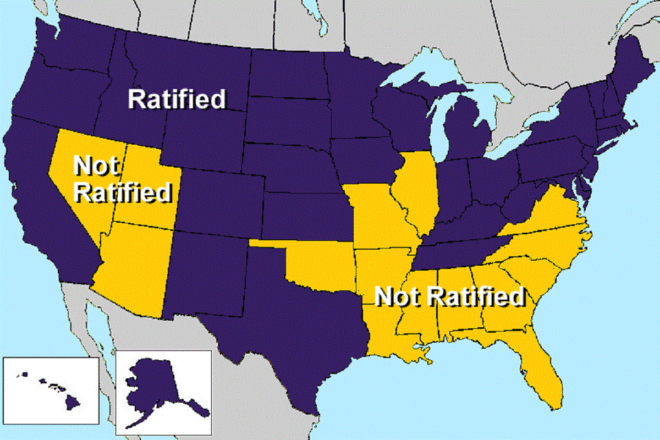A Small Ray of Light in Political News: Nevada’s Ratification of the Equal Rights Amendment
Indiana was the last state to ratify the amendment way back on January 18, 1977.

It’s been really tough to find good political news recently. But this week gave us a shining moment that we should all be incredibly excited about—Nevada became the 36th state to ratify the Equal Rights Amendment (ERA) to the U.S. Constitution.
No need to adjust your monitor or check whether this is a reprint of an article from the 1970s; this really did happen in 2017. You’d be right to wonder, though, as it’s been a long time since there’s been any movement on the ERA. In fact, what Nevada did on Monday was something no other state has done in more than 40 years, as Indiana was the last state to ratify the ERA way back on January 18, 1977.
Since then, nothing has happened. But that hasn’t stopped advocates from pursuing what has been called the “three-state strategy.” With Nevada finally ratifying, we need just two more states to affirm the Equal Rights Amendment, which reads, “Equality of rights under the law shall not be denied or abridged by the United States or by any State on account of sex.”
In order to amend the Constitution, both houses of Congress have to pass the amendment with at least a two-thirds majority. In the early 1970s, that happened by a large margin: The House approved the amendment in 1971 by a vote of 354 to 24 (with 51 abstentions), and the Senate adopted it in 1972 by a vote of 84 to 8 (7 abstentions). President Richard Nixon endorsed the ERA as well.
After the amendment passes through Congress, three-quarters of the states must adopt it before it becomes part of the Constitution. Within one year of the Senate approving the ERA, 30 states had adopted it, including Texas, Idaho, South Dakota, and Wyoming.
Things were looking great for an easy passage of the ERA, so much so that, in 1973, the U.S. Supreme Court avoided answering the question of whether sex discrimination should be treated with the same high level of scrutiny as race discrimination specifically because it seemed like the ERA was going to pass and decide the issue.
But right about the same time as the Court punted on the issue, the process slowed down. Opposition to the ERA became more vocal, with Phyllis Schlafly leading the charge. She warned that society would crumble if the ERA passed because women would be subject to the draft; men and women would have to use the same bathrooms; and gay people would be allowed to marry. Those arguments were enough to slow the process and eventually stop it. After the first 30 states ratified the amendment within a year of Congress, three more states ratified it in 1974. Then came North Dakota in 1975, and finally Indiana in 1977 for a total of 35.
Congress had originally given the states until March 22, 1979, to ratify the amendment, but extended that deadline for another three years until June 30, 1982. After Indiana, however, no other state ratified the amendment, leaving the effort three states short.
So why was Nevada able to act this week?
Because in 1992, the 27th Amendment was added to the Constitution. That amendment, which says that any congressional pay raise can’t take effect until after the next election, was originally approved by Congress in 1789. Again, that’s not a typo. It was part of the package of amendments that became the Bill of Rights (only ten of the 12 were ratified in 1791), but it took 203 years for enough states to ratify it. When that amendment was added to the Constitution after such a long period of dormancy, ERA advocates began their three-state campaign. After all, if an amendment can take 203 years to be ratified, that gave the ERA until at least 2175.
There’s one other hitch with this strategy. Several states have voted to rescind their approvals of the ERA—Idaho, Kentucky, Nebraska, Tennessee, and South Dakota all did so in the 1970s. However, there is well-established precedent for ignoring these retractions. States tried to retract their approval of the 14th Amendment (guaranteeing equality and due process) and the 15th Amendment (protecting the right to vote based on race) before those amendments were fully ratified. But those retractions were ignored, and both amendments became part of the Constitution regardless. ERA advocates argue the same should apply here.
Which brings us to where we are today. Here’s a map from the great Equal Rights Amendment website, not yet updated to include Nevada.

A seemingly easy 37th state to ratify the ERA should be Illinois, as it is one of the most reliably blue states in the country. There is currently a bill pending in the state to do just that. After that, the path becomes trickier, though Virginia is a possible target.
Regardless, we are now in a very different world than we were just a week ago: The ERA is back on the table as an issue in 2017.
And, with Neil Gorsuch being considered for the Supreme Court, it couldn’t come at a better time.
Gorsuch has championed the judicial philosophy of originalism. Originalism says that the Constitution should be interpreted as the people who voted for understood the language. One of the big problems with originalism is that the people who voted for many parts of the Constitution were bigots. In particular, the Constitution’s guarantee of equality, found in the 14th Amendment, was approved in 1868, a time when, to vastly understate it, women’s rights were not at all on the minds of those voting for the provision. Thus, as Justice Antonin Scalia stated multiple times, an originalist would have to say that the Constitution doesn’t protect women against sex discrimination. If Gorsuch is confirmed and lives up to his originalist billing, we should expect him to rule against women under the Constitution.
An Equal Rights Amendment would make this a non-issue. It would give the Constitution a clear textual commitment to sex equality, something even the Court’s most conservative justices couldn’t deny. There would certainly still be questions about how it would be interpreted—whether it includes a right to abortion or whether it protects trans rights, for instance—but adding the provision to the Constitution would finally put this basic issue of equality to rest.
After all, in 2017, isn’t it time that our foundational document recognize sex equality?

